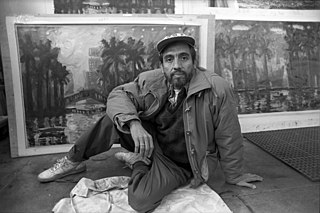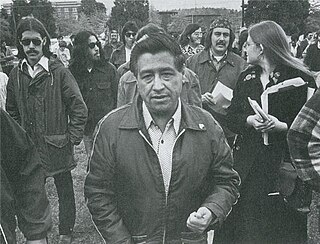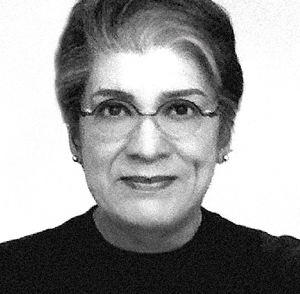
Carlos D. Almaraz was a Mexican-American artist and a pioneer of the Chicano art movement.

Gronk is the pseudonym of Chicano painter, printmaker, and performance artist Glugio Nicandro. His work is collected by museums around the country including the Smithsonian American Art Museum.

The Chicano Movement, also referred to as El Movimiento, was a social and political movement in the United States inspired by prior acts of resistance among people of Mexican descent, especially of Pachucos in the 1940s and 1950s, and the Black Power movement, that worked to embrace a Chicano/a identity and worldview that combated structural racism, encouraged cultural revitalization, and achieved community empowerment by rejecting assimilation. Before this, Chicano/a had been a term of derision, adopted by some Pachucos as an expression of defiance to Anglo-American society. With the rise of Chicanismo, Chicano/a became a reclaimed term in the 1960s and 1970s, used to express political autonomy, ethnic and cultural solidarity, and pride in being of Indigenous descent, diverging from the assimilationist Mexican-American identity. Chicanos also expressed solidarity and defined their culture through the development of Chicano art during El Movimiento, and stood firm in preserving their religion.
Los Four was a Chicano artist collective active based in Los Angeles, California. The group was instrumental in bringing the Chicano art movement to the attention of the mainstream art world.

The Centro Cultural de la Raza is a non-profit organization with the specific mission to create, preserve, promote and educate about Chicano, Mexicano, Native American and Latino art and culture. It is located in Balboa Park in San Diego, California.The cultural center supports and encourages the creative expression “of the indigenous cultures of the Americas.” It is currently a member of the American Alliance of Museums.

Chicana feminism is a sociopolitical movement, theory, and praxis that scrutinizes the historical, cultural, spiritual, educational, and economic intersections impacting Chicanas and the Chicana/o community in the United States. Chicana feminism empowers women to challenge institutionalized social norms and regards anyone a feminist who fights for the end of women's oppression in the community.
Gilbert "Magu" Luján was a well known and influential Chicano sculptor, muralist and painter. He founded the famous Chicano collective Los Four that consisted of artists Carlos Almaraz, Beto de la Rocha, Frank Romero and himself. In 1974, Judithe Hernández became the "fifth" and only female member of Los Four.
Diane Gamboa has been producing, exhibiting and curating visual art in Southern California since the 1980s. She has also been involved art education, ranging from after-school programs to college and university teaching. Gamboa has been "one of the most active cultural producers in the Chicana art movement in Los Angeles." She actively developed the Chicano School of Painting.

Judithe Hernández is an American artist and educator, she is known as a muralist, pastel artist, and painter. She a pioneer of the Chicano art movement and a former member of the art collective Los Four. She is based in Los Angeles, California and previously lived in Chicago.

The Chicano Art Movement represents groundbreaking movements by Mexican-American artists to establish a unique artistic identity in the United States. Much of the art and the artists creating Chicano Art were heavily influenced by Chicano Movement which began in the 1960s.
Patssi Valdez is an American Chicana artist. She is a founding member of the art collective, Asco. Valdez's work represents some of the finest Chicana avant-garde expressionism which includes but not limited to painting, sculpture and fashion design. She lives and works in Los Angeles, California.
Willie Herrón III is an American Chicano muralist, performance artist and commercial artist.
Yreina Cervantez is an American artist and Chicana activist who is known for her multimedia painting, murals, and printmaking. She has exhibited nationally and internationally, and her work is in the permanent collections of the Smithsonian American Art Museum, The Mexican Museum, the Los Angeles County Museum, and the Los Angeles Museum of Contemporary Art.
Chicano Art: Resistance and Affirmation was a traveling exhibit of Chicano/a artists which toured the United States from 1990 through 1993. CARA visited ten major cities and featured over 128 individual works by about 180 different Chicano/a artists. The show was also intended to visit Madrid and Mexico City. CARA was the first time a Chicano exhibit received major attention from the press and it was the first exhibit that collaborated between Chicanos and major museums in the U.S. The show was considered a "notable event in the development of Chicano art." Another unique feature of CARA was the "extensive planning" that attempted to be as inclusive as possible and which took place more than five years prior to the opening at Wight Art Gallery.
Lorraine Garcia-Nakata is an American artist who works with various mediums including pastel, charcoal, ceramics, printmaking, installation, sculpture, and paint. Her work surrounds themes of the daily life, portraiture, and realism and is known for her large scale artworks. She is a member of the Royal Chicano Air Force (RCAF) artist collective since 1974.
Sandy Rodriguez was born in 1975 in National City, California. She is a Los Angeles based artist who grew up on the US-Mexico border, in Tijuana, San Diego, and Los Angeles. She has exhibited her works with numerous museums and galleries, including the Denver Art Museum, The Huntington Library, Art Museum and Botanical Garden, the Amon Carter Museum of American Art, Los Angeles County Museum of Art, Museum of Contemporary Art San Diego, MOCA Busan Busan Bienniale, Crystal Bridges Museum of American Art, The Cheech Marin Center for Chicano Art, Art+Practice, and Self Help Graphics. Her work focuses on the ongoing cycles of violence on communities of color by blending historical and recent events in the Los Angeles area and along south-west US-Mexico border. A transitional moment for Rodriguez happened in 2014 on a visit to Oaxaca, a southern Mexican Region, where she first procured a red pigment called cochineal, coming from the pre-Columbian era. Prior to this, Rodriguez had painted exclusively in modern paint. The encounter with cochineal happened at the same time she was painting fire paintings and the protests began in Ayotzinapa Mexico in response to forty-three missing college students, which included setting fire to palacio nacional and an Enrique Peña Nieto effigy pinata. The alignment of content, form, and the materials magnified how material can signal cultural identity, history, and politics. A goal of her work is to disrupt dominant narratives and interrogate systems that are ongoing expressions of colonial violence witnessed regularly, including Customs Border Enforcement, Police, and Climate Change.
The Cheech Marin Center for Chicano Art, Culture & Industry of the Riverside Art Museum, or The Cheech, is an art museum and academic center in Riverside, California, United States. The center will focus on the presentation and study of chicano art from across the United States. It is a collaborative effort between stand-up comedian, actor, and writer Cheech Marin, who will donate his collection of more than 700 pieces of Chicano art, the City of Riverside, which will provide the facilities to house the collection, and the Riverside Art Museum, which will manage the center. The collection will be housed in the old Riverside public library, and when complete, the center is expected to be a world-class institution to research and study "all things [related to] Chicano art". It will be the first North American facility dedicated to Mexican-American art.
Yolanda González is an American multimedia artist based in Los Angeles. She primarily works in ceramics, drawing, painting, and printmaking.
Frank Edward Romero is an American artist considered to be a pioneer in the Chicano art movement. Romero's paintings and mural works explore Chicano and Los Angeles iconography, often featuring palm trees and bright colors.
Joe "Peps" Galarza is a Chicano artist, educator, and musician based in Los Angeles. He is the bassist for the Chicano rap group Aztlan Underground.






